B: VOVWORLD’s programs are available in 13 languages: English, French, German, Spanish, Russian, Chinese, Japanese, Korean, Indonesian, Thai, Lao, Cambodian, and Vietnamese. Each section will reply to letters and reception reports in that language. You’ll find the email address of each language section on our website at www.vovworld.vn.
A: American listener Richard Nowak said he enjoyed our show on 7315 khz on July 30. The reception was a little weaker than usual with SINPO rating at 44533. The news bulletin had interesting information about an International Martial Arts Festival in HCMC where the Vietnamese team won a gold medal. A pop song called ‘Vietnam My Homeland’ was very nice, Richard said.
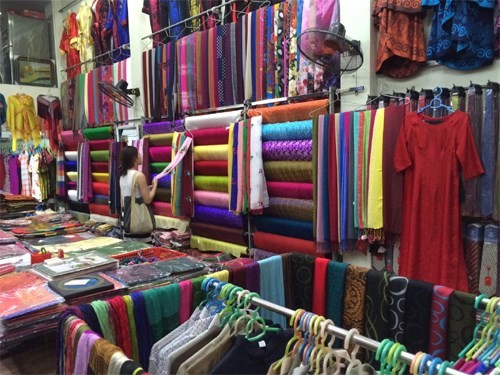 Van Phuc is a famous silk village on the outskirt of Hanoi Van Phuc is a famous silk village on the outskirt of Hanoi
|
B: The Sunday Show, our biggest show of the week, is always a favourite with our listeners. Richard said: “The great Sunday Show discussed silk production. This was very interesting, describing looms and today’s use of automatic machinery. The silk making industry was discussed and there was an interview with a man fascinated by Vietnamese silk making. The high quality of the silk allows it to be dyed a variety of colors. There was some acoustic fading during the program but what I heard was very interesting.”
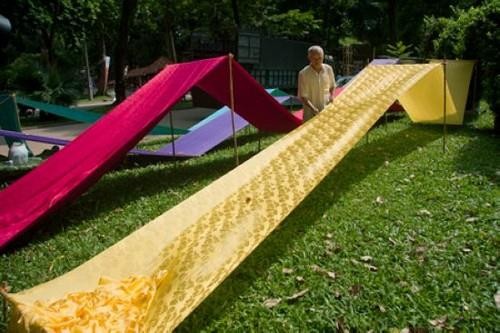 Silk is dyed and sun dry. Silk is dyed and sun dry.
|
A: Thank you, Richard, for sending us regular feedback and for your support of shortwave. A listener asked us to put him in contact with stamp collectors in Vietnam who would be interested in trading postage stamps. We’ll send you the addresses of some Vietnamese stamp clubs and you can contact them.
B: There is a stamp market in Hanoi which opens every Sunday morning in Trieu Viet Vuong Street. Stamp lovers come there to browse and trade stamps. The market is in the tiny front yard of Mr. Pham Hao, a well-known Hanoi stamp collector.
A: At first, a few local collectors just gathered to talk about and show off their stamps. Eventually, collectors from many other places started coming there and a stamp market was formed.
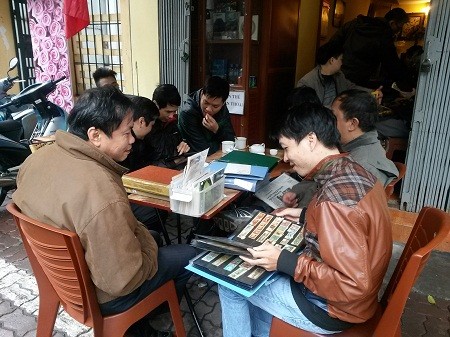 Stamp collectors share their hobby Stamp collectors share their hobby
|
B: Stamps feature historical figures such as Ho Chi Minh, the army, ancient objects, famous paintings, clothing, landscapes, animals, flowers, and plants. Each person brings his or her own collection to the stamp market to share with other stamp lowers.
A: Jayanta Chakrabarty of India sent us a reception report on a shortwave transmission he heard on August 4th. He told us: “A regular listener, I enjoy listening to the news and Current Affairs programs, which are informative and interesting. I also listen to VOV on the internet whenever I miss a radio program. The website is attractive and has quality programs.”
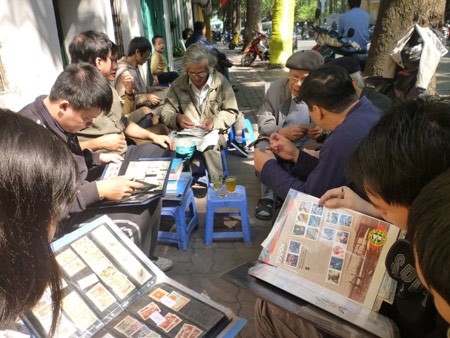 Stamps market in Trieu Viet Vuong street in Hanoi. Stamps market in Trieu Viet Vuong street in Hanoi.
|
B: Javanta said, “As an economist, I think the steps being taken to re-structure Vietnam's economy are encouraging. A second report on one aspect of Vietnamese culture was interesting. It discussed Vietnam's expertise in clothing design and its traditional long dress.”
A: Yes, in recent years, Vietnam’s traditional long dress, the Ao dai, has established a reputation at international fashion shows, thanks in part to Vietnam’s talented designers, who work hard to promote the Ao dai to the world.
B: An Ao dai is custom fitted to each customer's shape to create a graceful look. Its body-hugging top flows over wide trousers that brush the floor. The pants should reach the soles of the feet and flow along the floor. Splits in the gown extending well above waist height make it comfortable and easy to move in. The Ao dai appears to flatter every figure. Foreigners who visit Vietnam often buy an Ao dai to wear at home or give as a gift.
A: Indian listener Siddhartha Bhattacharjee asked “What is the largest and oldest university in Vietnam? Is it a public or private university?”
B: The oldest university and possibly the finest architectural complex in Hanoi is Van Mieu, or the Temple of Literature, which was built in 1070, during the Ly Dynasty. Founded in honor of the Chinese philosopher Confucius, it served as a center for learning and educating future mandarins for more than seven centuries.
A: After years of study, students were allowed to take the first-degree examinations held once every three years at their locality. Those with the highest marks in this exam were named bachelors. A year later, they travelled to the capital to take an examination for a doctorate degree. Passing the highest exam earned the equivalent of a post doctorate. Successful candidates were eligible to join the ranks of the mandarins.
B: In the Temple of Literature, there are 82 stone steles. The oldest ones record the 1442 exam results and the most recent ones the 1779 exams. They are the most precious relics at the Temple of Literature.
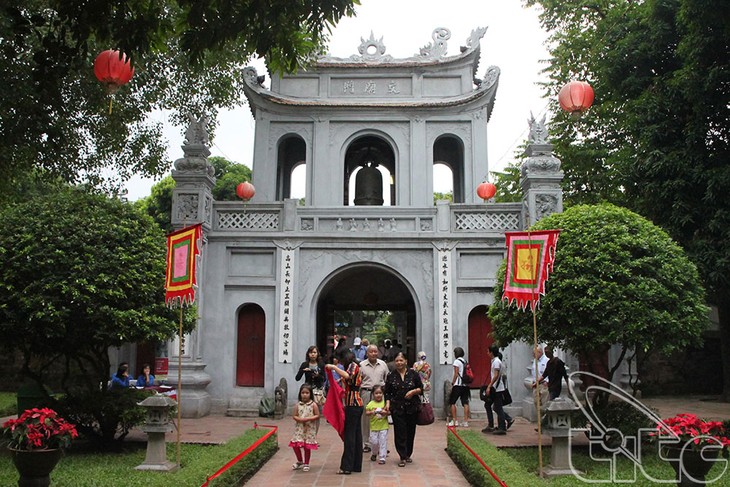 The Temple of Literature in Hanoi The Temple of Literature in Hanoi
|
A: Part of the Temple of Literature is the Imperial College of the Le Dynasty. When the Nguyen Dynasty moved the college to Hue, this area was converted to a temple dedicated to Confucius. In the past, Van Mieu was held in great reverence not only as a major centre of Confucianism, but as the apogee of learning in Vietnam and the only route to becoming a mandarin.
B: Today, the Temple of Literature remains a symbol of learning. At the beginning of a new year, people visit the site to pray for their children to have good academic results. Before major examinations, parents and children come here to pray to the Confucian philosophers for success. The Temple of Literature is a popular stop on the Hanoi city tour.
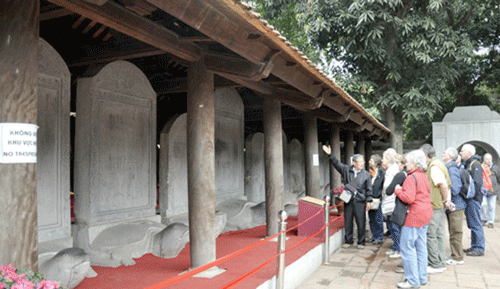 Stone steles honor top winners of exams 1442 to 1779. Stone steles honor top winners of exams 1442 to 1779. |
A: The biggest and most prestigious university in Vietnam is the Vietnam National University in Hanoi (VNU). It was the first modern university established in Vietnam and is still one of only two national universities. The other is the Vietnam National University in Ho Chi Minh City. First established as the University of Indochina in 1906, VNU has undergone various stages of development to become the largest comprehensive higher education and research centre in Vietnam. VNU holds a special position in Vietnam’s higher education system, reporting directly to the Prime Minister and enjoying a high level of autonomy.
B: It has six member universities, colleges, schools, research institutes, and centers. VNU is one of four universities in Vietnam that have programs accredited by the ASEAN University Network (AUN-QA). VNU has hosted students from English speaking, European and Asian countries. It cooperates with more than 135 foreign universities and research institutes.
A: This week we acknowledge letters from Jayanta Chakrabarty and Madhab Chandra Sagour of India, Miss Samina Gul of Pakistan, and Malik Allah Bachaya Khokhar of Bangladesh’s Sungat Radio Listeners’ Club.
B: We’ll send QSL cards to confirm your reports. We welcome your feedback at English Service, VOVWORLD, the Voice of Vietnam, 45 Ba Trieu Street, Hanoi, Vietnam. Our email address is englishsection@vov.org.vn. When we verify your reports we’ll send you our latest frequency list and program guide.
A: Thank you for listening. Please join us again next Wednesday for another edition of the Letter Box. Goodbye.